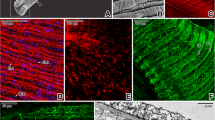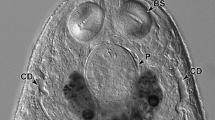Abstract
Developmental stages of the diplozoid monogenean Eudiplozoon nipponicum, comprising oncomiracidium, diporpa, juvenile, and adult, were investigated using light and scanning electron microscopy in conjunction with confocal scanning laser microscopy in order to examine body organization and identify explicit morphological adaptations to the ectoparasitic life in each stage. The parasite exhibits a complex digestive tract well equipped for hematophagous feeding. It consists of a mouth opening with prominent buccal suckers, eversible pharynx with adjacent glandular structures, and a blind-ending gut with cecal lining. Glandulo-muscular organs, located apically and opened into the mouth corner, are considered to be a part of the digestive tract. Based on our observations of pharynx eversion and in light of the presence of several glandular or gland-like structures, we propose a new hypothesis on the possibility of extracorporeal digestion of this parasite. The hindbody bears an attachment apparatus, comprising haptor, lobular extensions, and tegumental folds, responsible for the parasite’s firm attachment to the host gills. The possibility of buccal suckers assisting in the parasite’s translocation while searching for an optimal niche or their temporary attachment function during feeding is discussed. The body of each compound adult (i.e., permanent copula) is almost completely filled by two complete reproductive tracts comprising the female as well as male organs. Such a reproductive strategy, in which two independent heterogenic individuals fuse into a single hermaphrodite organism without the need to search for mating partner, represents a high specialization of diplozoids to their parasitic life.








Similar content being viewed by others
References
Bovet J (1967) Contribution a la morphologie et a la biologie de Diplozoon paradoxum v. Nordmann, 1832. Bull Soc Neuchatel Sci Nat 90:63–159
Bykhowsky BE (1957) Monogenetic trematodes, their classification and phylogeny. Academy of Sciences U.S.S.R., Moscow: Leningrad (in Russian)
Gerasev PI (1994) The structure of the reproductive system in diplozoids (Monogenea). Parazitologiya 25:475–487
Goto S (1891) On Diplozoon nipponicum, n.sp. J Coll Sci Imp Univ Tokyo 4:151–192
Hodová I, Matejusova I, Gelnar M (2010) The surface topography of Eudiplozoon nipponicum (Monogenea) developmental stages parasitizing carp (Cyprinus carpio L.). Cent Eur J Biol 5:702–709
Justine JL, Le Brun N, Mattei X (1985) The aflagellate spermatozoon of Diplozoon (Platyhelminthes: Monogenea: Polyopisthocotylea): a demonstrative case of relationship between sperm ultrastructure and biology of reproduction. J Ultrastruct Res 92:47–54
Kamegai S, Ichigara A, Kata K, Nonobe H, Machina M (1966) Diplozoon nipponicum Goto, 1891. Part 1: morphological observations on the worms obtained from Cyprinus carpio. Mon Rep Meguro Parasit Museum 41:1–6
Kawatsu H (1978) Studies on the anemia of fish—IX. Hypochromic microcytic anemia of crucian carp caused by infestation with a trematode, Diplozoon nipponicum. Bull Japan Soc Sci Fish 44:1315–1319
Khotenovsky IA (1977) Life cycle of several monogeneans of the genus Diplozoon. Parazitol Sb 27:35–43 (in Russian)
Khotenovsky IA (1985) Fauna of the USSR. Monogenea. Suborder Octomacrinae Khotenowsky. Nauka, Leningrad (in Russian)
Kornakova EE (1983) Structure of the gut’s front parts of some representatives of diplozoonins (Monogenea, Diphozoidae). Parazitol Sb 31:95–107
Lambert A, Le Brun N, Renaud F (1987) L’étrange reproduction d’un ver parasite. La Recherche 194:1548–1551
Llewellyn J, Owen IL (1960) The attachment of the monogenean Discocotyle sagittata Leuckart to the gills of Salmo trutta L. Parasitology 50:51–59
Lyons KM (1966) The chemical nature and evolutionary significance of monogenean attachment sclerites. Parasitology 56:63–100
Matejusová I, Koubková B, Cunningham CO (2004) Identification of european diplozoids (Monogenea, Diplozoidae) by restriction digestion of the ribosomal RNA internal transcribed spacer. J Parasitol 90:817–822
Owen IL (1963) The attachment of the monogenean Diplozoon paradoxum to the gills of Rutilus rutilus L. 2. Structure and mechanism of the adhesive apparatus. Parasitology 53:463–468
Pečínková M, Matějusová I, Koubková B, Gelnar M (2007a) Investigation of Paradiplozoon homoion (Monogenea, Diplozoidae) life cycle under experimental conditions. Parasitol Int 56:179–183
Pečínková M, Vøllestad LA, Koubková B, Gelnar M (2007b) Asymmetries in the attachment apparatus of a gill parasite. J Zool 272:406–414
Poulin R (1998) Evolutionary ecology of parasites: from individuals to communities. Chapman and Hall, London
Smyth JD, Halton DW (1983) The physiology of trematodes, 2nd edn. Cambridge University Press, Cambridge
Zurawski TH, Mair GR, Mousley A, Brennan G, Maule AG, Gelnar M, Halton DW (2000) Immunomicroscopical studies of the neuromusculature of the monogenean parasite, Eudiplozoon nipponicum. Acta Parasitol 45:166
Zurawski TH, Mousley A, Mair GR, Brennan GP, Maule AG, Gelnar M, Halton DW (2001) Immunomicroscopical observation on the nervous system of adult Eudiplozoon nipponicum (Monogenea: Diplozoidae). Int J Parasitol 31:783–792
Zurawski TH, Mair GR, Maule AG, Gelnar M, Halton DW (2003a) Microscopical evaluation of neural connectivity between paired stages of Eudiplozoon nipponicum (Monogenea: Diplozoidae). J Parasitol 89:198–200
Zurawski TH, Mousley A, Gelnar M, Halton DW (2003b) Cytochemical studies of the neuromuscular systems of the diporpa and juvenile stages of Eudiplozoon nipponicum (Monogenea: Diplozoidae). Parasitology 126:349–357
Acknowledgments
The authors are grateful for the financial support provided by projects GA 524/07/1610 from the Czech Science Foundation; Long-term Research Plan MSM 0021622416 Funded by Ministry of Education, Youth and Sports of Czech Republic; and Ichthyoparasitology Research Centre LC522 from the Ministry of Education, Youth and Sports of Czech Republic. The authors would like to thank Dr. Tomáš H. Zurawski for his constructive comments and suggestions.
Author information
Authors and Affiliations
Corresponding author
Rights and permissions
About this article
Cite this article
Valigurová, A., Hodová, I., Sonnek, R. et al. Eudiplozoon nipponicum in focus: monogenean exhibiting a highly specialized adaptation for ectoparasitic lifestyle. Parasitol Res 108, 383–394 (2011). https://doi.org/10.1007/s00436-010-2077-6
Received:
Accepted:
Published:
Issue Date:
DOI: https://doi.org/10.1007/s00436-010-2077-6




